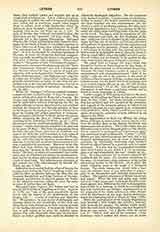

Lunette, known in Germany as the lunula and also as the melchisedech, is a crescent-shaped clip made of gold or of silver-gilt which is used for holding the Host in an upright position when exposed in the monstrance. The crescent which holds the Host is securely attached to a small stand or frame and the receptacle of the monstrance is usually provided with a groove into which the stand fits so as to be held firmly in its place. Most commonly, however, nowadays as a precaution against accidents, the Host is not merely fixed between two crescent-shaped strips of metal but is enclosed in a pyx with two glass faces and this pyx is itself inserted bodily into the receptacle of the monstrance. The lunette was certainly in use before the Reformation and it is to be found in many of the monstrances of the fifteenth century which are still preserved to us (see the list in Otte-Wernicke, “Handbuch”, I, 243). Already in 1591 Jakob Muller in his “Kirchengeschmuck” gives a. detailed description of the lunette, or “monlein”, and points out the desirability that the two strips of metal that form the clip should be separable so as to permit of their being thoroughly purified when the Host is changed. If a glass pyx is used it ought to be possible so to fix the Host that it does not remain in contact with the glass (Decree of S. Cong. of Rites, February 4, 1871).

